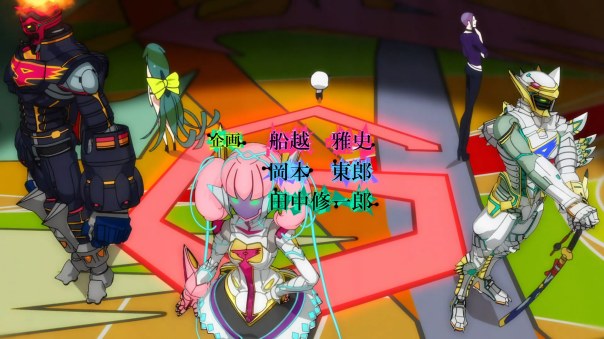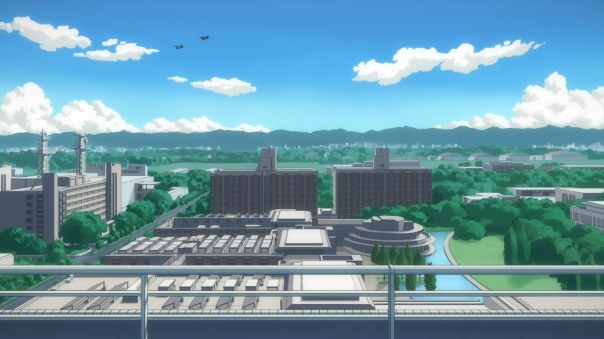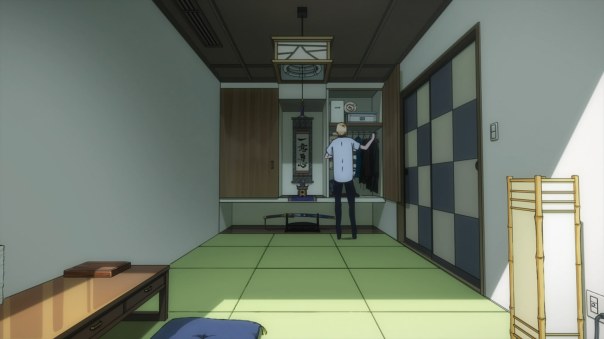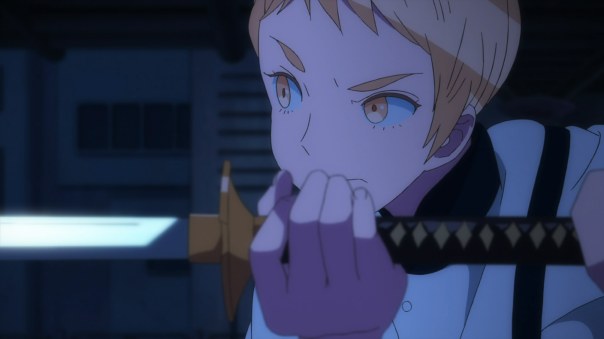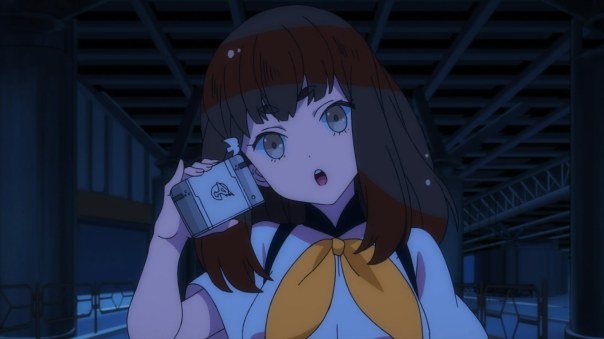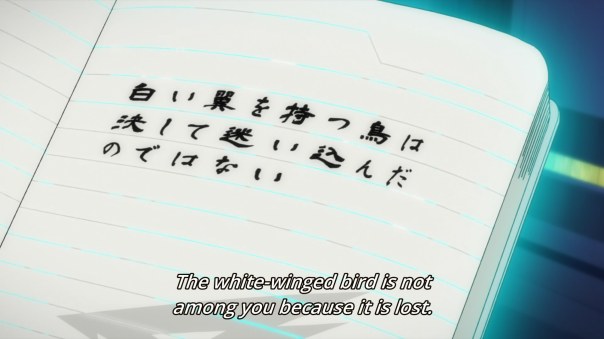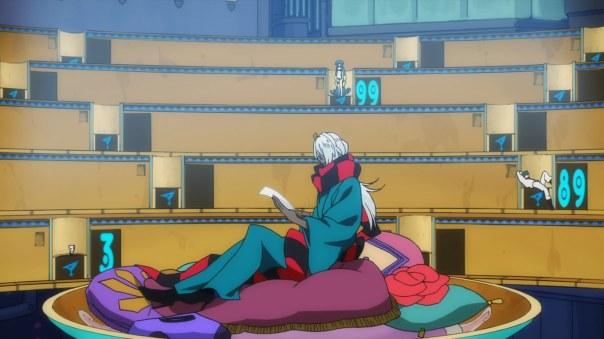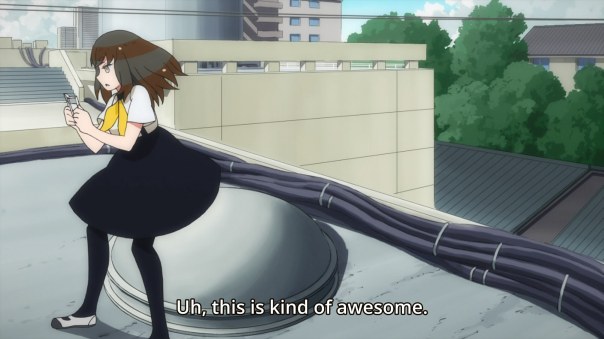 [Translated and adapted from the original French version]
[Translated and adapted from the original French version]
The first season of Gatchaman Crowds aired two years ago and I wanted to write a detailed analysis of it since then. But this series has so much to say in just twelve episode that I have constantly failed to finish this task because I don’t know where to start and to end my commentary. So now I have decided to take it episode per episode and see if that works better.
The second season, Insight, is way less dense and much more focused on a single theme, so I can already announce that it will only get a single review from me once it’s over. I will also ignore it most of the time in my analysis of season 1. Not that I dislike Insight, but I want to look at the messages of the first season in their own context.
Gatchaman Crowds is a sort-of reboot of the Sentai series also known as Battle of the Planets. It is still about superheroes protecting Earth from aliens but yet it’s also much more than that. These analyses will be spoilers heavy, but hey, if you haven’t watched the series yet, it’s available on Crunchyroll. If you want to see a fun, yet intelligent, anime that subverts superheroes tropes without going grimdark or that offers the first relevant commentary on how internet influences our society since Lain, you will get what you bargained for.
.
Episode title
All episodes of Gatchaman Crowds are titled after artistic movements or art-related concepts. This episode is titled “Avant-garde”. In art, this refers to a movement, a work, or an artist turned toward novelty and experimentation. It is also tied to the idea of breaking away from conventions and academic codes. In a way, the series directly announces its focus on modern ideas and its intent to subvert archetypes to make the spectator think. This title choice for this precise episode is a little strange though, since as we’ll see in a minute, it introduces a lot of classic anime elements, without yet subverting them until the next episodes. Maybe the title is an invitation to look for the hidden meanings that we will study in this article, or it’s simply used in a literal way and refers to the introductory role of this episode.
.
Sugane, a lawful hero… yet an unjust one
When the series was first broadcast, I saw a few people described it as too cliché and drop it it after only watching the first episode. I’m not blaming them at all because this episode hides its true hand with an agility that I can only describe as art, and that’s why I always advises people to watch up to the second episode at least to get a proper idea of what the story is about. This episode is deceiving to the point that some of the things I’m going to talk about took me several rewatchs to notice.
What makes the genius of this episode is that it purposefully present itself as cliché, while still containing hints of the real direction of this series, which includes some scenes with double meanings. The beginning of the episode focuses on Sugane, an upright teenager who seems like the perfect superhero candidate. He is a model of civility in his everyday life and fight mean monsters at night. Hard to think that you could shine a negative light on him, and yet the anime does just that right from start.
What, you don’t see what I’m talking about? Here are the two first wide shots of the series (which are only separated by a quick zoom of Sugane putting his clothes on).
The first shot of a view of the exterior, an open and alive scenery. The colors of the sky, the nature, and even the white buildings are bright and merge together harmoniously. The horizon is far away and the only roof is the sky. We can also hear helicopters, which give a sense of human activity despite the motionless picture.
But then, what follows is Sugane bedroom, which is literally a box. This aspect is reinforced by the placement of the camera at the center of the fourth wall and the fact that almost every element of the room has a square or rectangular shape. The room is also decorated in a traditional and austere way. It’s way smaller than the previous scenery and yet feels more empty. The place is so clean that it doesn’t feel like someone is living here. Sugane stands in the shadow that covers most of the room, and the colors are washed out. It can be noted that Sugane’s NOTE is standing in the center of this set.
These shots already announce a lot of things for the rest of the story, starting with a simple metaphor on the fact that Sugane and the other Gatchamen are stuck on their traditional rules, in particular the one of secrecy, and the exterior and modern world has left them behind. A reversal of stereotypes can also be noted: generally, medias represent tradition and austerity as the way to be in harmony with nature and to escape a suffocating modernity. But here, the opposite is shown: modernity is in harmony with nature while tradition and austerity are suffocating.
One of the key idea behind Hajime’s philosophy is to not judge people based on appearances or first impressions. Sometimes, you have to look at things from a different point of view to get a clearer idea of things, but Sugane is unwilling to do so. He follows rules to the letter and apply them to any situation without thinking about it, like in the tramway scene.
When you watch it for the first time, everything seems fine: Sugane demands of a young man who is sitting down in the train to leave his seat to a pregnant who is standing up. This ten seconds moment allows us to naturally discovers Sugane’s upright personality. But when you rewatch it with knowledge of Hajime’s philosophy in mind, it can take on a very different meaning, beyond its introductory role.
What word would you use to describe this character?
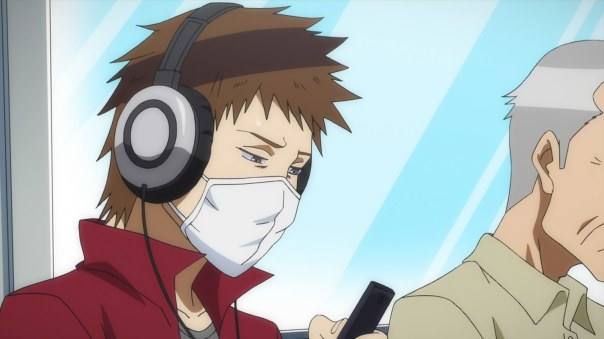
(By the way, while it’s not perfect, the English dub is really a blast to listen to and is full of great lines that will make you laugh. Give it a try!)
The answer I expect is something along the lines of “punk”, “thug”, or “whippersnapper”. With his surgeon mask, his messy short hair, his unfolded collar, and his headphones, the design of this character is purposefully suggesting this conclusion to the spectator. Plus, this character is a nameless extra who is pitted against Sugane, our upright hero, so of course it’s easy to associate him to the “rude extra” archetype that is used in some animes to make the main character look good by contrast (for example, Samurai Flamenco uses it straight in its first episode).
But if we take the time to stop and think about why the man is sitting down, we can notice some new details: the man is sweating and has rings under his eyes. Also, who in Japan wears surgeon mask in public? Yup, people who are sick! This young man is sick and so probably needs to sit down to catch a rest. Even more, if we look at the pregnant woman, she seems perfectly fine. Thus, while it goes against etiquette, in this particular situation the man needs the seat more than the woman. As upright as Sugane is, it turns out he didn’t take the right decision and only made things worse instead of better.
This scene is very interesting because it’s the only one in the series that demonstrates Hajime’s philosophy as being correct (all the later scenes leave her optimistic speculations as simply that: speculations) and it requires a rewatch in order to be recognized. I’m really impressed by this scene as it’s basically a magic trick. The setup tricks the spectator in recognizing the archetype and not thinking further, even though the truth is right under their nose. And it’s not even the only time that the series will do something like this.
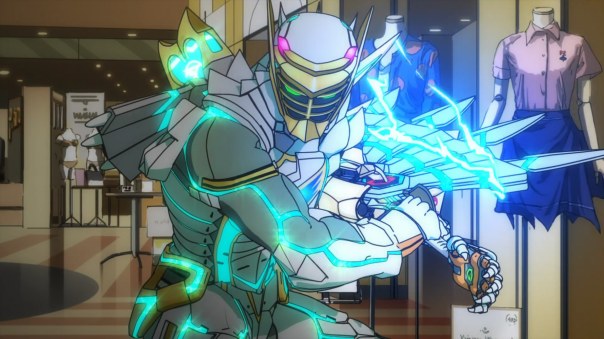
Though the episode re-centers itself around Hajime after Sugane’s introduction, his problematic adventures don’t stop there. He confronts the MESS at the mall, which is the occasion for him to transform in his cool costume for the first time on screen and to make a speech about justice & stuff to establish himself as the hero. Yet, on the other side of things, the attitude of the MESS doesn’t really correspond to what is expected of an evil monster. The MESS doesn’t answer Sugane’s taunt and even ignores him completely, and once attacked, it simply runs away. Even the second MESS of the episode, which does react to Sugane’s presence (by turning on its bus lights and opening its door), will run away just the same. When you think about it, Sugane is the aggressor in those scenes.
And thus, we already get to see how Sugane’s vision of super-heroism doesn’t really match with the reality of things, as it is less black & white and more complex than he assumes. He also envisions his role as a strict enforcer of rules, and obviously no rule is perfect for every situation, but it even shows that he is very unquestioning of how things are done and it ironically makes him incompetent as his job. He can’t evaluate correctly what the problems are and what help is actually needed because he values rules over human compassion and empathy. In general, this episode gives the illusion that the Gatchamen are functioning well, because, by their own black & white metric, they technically are. The system works within in its own logic, and it’s certainly entertaining to watch superheroes beat up villains, but it’s not actually helping solve any problem.
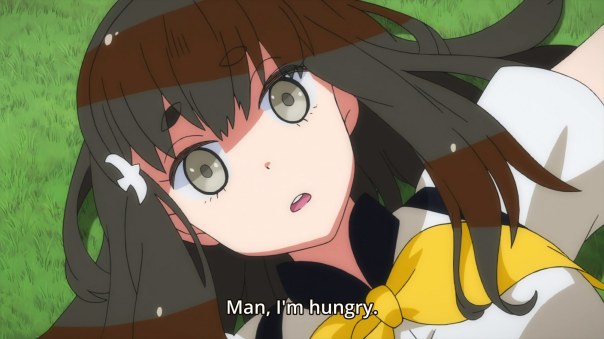
.
Hajime is not an idiot!
But still in this perspective to make us believe that Sugane is in the right, this episode also plays with our perception of Hajime. It purposefully pushes forward her “genki” (overly-excited) attitude to make us think of the stereotype of the excited and easily-distracted female character, like the scene where Hajime admires her NOTE while seemingly ignoring Sugane. I think we are also supposed to see Hajime bubbly attitude as rude towards her “senpai” (senior) because you’re supposed to listen to and obey the social hierarchy religiously. But we’ll see in the next episode that Hajime’s social interactions with the other Gatchamen are not the result of a tumultuous or distracted personality, but rather of a political choice.
Plus, it’s presumptuous to actually believe that Hajime is easily distracted. If we observe her carefully throughout the episode, we can see that she listens carefully to any technical instruction given to her. Paiman even says out loud that she is a quick learner. Hajime also learn how to teleport out of J.J. sanctuary and transform in her Gatchaman costume simply by observing Sugane and imitating him. It’s why she infamously pronounce her first “Bird, go!” in a interrogative tone: she was aping Sugane and wasn’t sure it was going to work. She also shows initiative by being the only person who questions the MESS’ motive, which is exactly the kind of thing that J.J. actually expect of the Gatchamen. Despite being ignored by everybody else, she continues to think: she carefully examines the MESS-bus without immediately attacking like Sugane and without doing something reckless like getting in through the opened door. We are not told what exactly, but something about the MESS bothers Hajime.
When this episode first aired, I saw a few people expecting the rest of the series to have Hajime’s character “grow up” and learn to integrate in the G-crew’s established order, and I think that’s one the thing this episode is the most crafty about: the real difference between Hajime and Sugane. The trap is to establish a value judgement between the characters, the reasonable older Sugane and the impudent newbie Hajime, but the true difference is shown with a tiny detail when they meet for the first time: they both bump into a passer-bye in turn, but each have a different reaction to it. Sugane is surprised and freeze, which causes the passer-bye to get irritated at him and vice-versa, while Hajime reacts without much fuss by saying sorry and moves on. These two discrete moments establishes the characters in almost literal ways: Sugane only look straight ahead and dismiss what is outside of his perspective, while Hajime is opened minded and doesn’t react with hostility to new things suddenly showing up.
But you guys are probably gonna tell me that this is extrapolating way too much from small stuff, so let’s look at more literal things: one of J.J.’s prophecies. He announces word for word that he chose Hajime for a good reason (which he’ll come to regret in a very interesting scene in the next episode). Hajime will be confirmed by other characters to be the white-winged bird in a future episode but it’s already pretty obvious since birds are the fetish animal of the Gatchamen and white is the color of NOTE… Also, well, she has a hairpin with a literal white bird motif. And because we can’t get enough symbolism, when Hajime transforms for the first time at the end of the episode, we get a quick cut of J.J. animating a white paper bird.
A last thing of note with Hajime in this episode is the introduction of another form of symbolism that will continues throughout the series: hunger as a metaphor for boredom. When Hajime go to the roof to eat her lunch, we see her complaining about being hungry, even though her lunch box was barely touched and has plenty of food left. Just after that, she meets J.J. and becomes a Gatchaman. She inspects her NOTE and when she decides to leave school to meet up with Sugane, she declares that she is “gonna get full”. Hunger is used to highlight a lack of fulfillment among the major characters of the first season. This fulfillment comes mainly from having fun and passion, but each of them have a different idea about what constitutes a great way to have fun. For Hajime, it’s about helping people and being a superhero.
That’s pretty much all for what concerns Hajime directly in this episode, but we’ll really explore the depths of the character in later episodes. A last important moment involving her in this episode is her meeting with G-crew. A short but pretty significant scene that introduces many characters that we will get to know better in due time.
.
The G-Crew, a bunch of clichés… but not just that
When you want to introduce a bunch of characters quickly, you’ll need big obvious characteristics that makes it easy to distinguish them on first glance. Gatchaman Crowds uses striking color-coded designs (Utsutsu is green, O.D. is purple, etc) and recognizable stereotypes. Utsutsu is the fanservice lolita, O.D. is the exuberant camp gay guy, Joe is the dark hero, and finally Paiman is both the mascot and the strict leader. You usually end up with one-dimensional characters when the story doesn’t explore the characters further in later parts, but if you are reading this, you probably already know how well developed GatchaCrowds’ characters get in future episode. But did you know that hints of the character being more than their facade are already present in this episode?
The most interesting example is when O.D. lies by omission to Hajime to imply that he is weak and play on a fragile effeminate man image purposefully, with the goal of testing Hajime’s reaction. When she answers his greeting without batting an eye, nor judging him, he drops his mask in surprise and gives her a very serious look for a second before regaining his composure.
In parallel, it can be noted that all the Gatchamen are numbered in an implied seniority order (if we don’t count Tsubasa in season 2), which gives us additional insight on their personal situations. But first of all, there is a hundred plus one Gatchamen, just like the Hundred plus Rui, which suggests that the two organisations are a reflection of each other. On a individual level, Hajime is the 101th member, which suggests her role as a new beginning for the group, and as for O.D., the fact that he is n°12 when all the other humans characters are near the end of the count foreshadows his half-alien nature.
There is not much to say about Joe outside of the fact that I find his dark hero attitude pretty funny in hindsight because it’s not his real personality and he is just trying to act in a way that he thinks is cool. In a way, he is kind of a chuunibyou (someone who imagine themself in extraordinary scenarios as a form of escapism). He is the oldest known human of the team as n°89.
More than a simple mascot, Paiman is the oldest member of the team in 3rd position. He acts as leader of the group but we can already observe his difficulties with this role. Any rule he tries to teach Hajime (in particular the rule about not using the NOTEs for personal use), he attributes to J.J., which is an obvious lie in hindsight considering we never see J.J. edict any rule and it contradicts his “make your own judgement” prophecy. Paiman even affirm that J.J. will punish those who break the rules, even though J.J. will completely ignores even rogue Gatchaman Berg-Katze attacking him in the last episode.
Paiman describes J.J. as a religious figure and uses it to dodges the responsibility of his own choices, by attributing them to this convenient (mostly) silent being. This rejection of responsibility through religion is a theme that we’ll see again in future episodes. J.J. status will also play an interesting role in his relationships with other characters. On that subject, we can take note of the Spiritual Precipice, a literal gap separating J.J. from mortals (and I will explain in a future episode why this blog is named after this place).
And finally, Utsutsu is more than an expy of Rei, and as she says herself, she is “gloomy” (a line mistranslated in both most of the Crunchyroll subs and the dub of the DVDs/Blu-rays. Poor Utsutsu can’t catch a break). Utsutsu is depressed and anxious about her role as a Gatchaman and hates herself because of her potentially dangerous power. We can see in this episode that she specifically protect her hands but she lets Hajime touch the rest of her body, which foreshadow the exact cause of her moodiness. Utsutsu is n°99, which makes the most recent member after Hajime. Before noticing this detail, I had thought that Utsutsu was a more ancient member, but her number reveals that the mantle of hero is still probably new to her and she is still uncomfortable with it. I have also wondered before if Utsutsu was a half-alien like O.D., but the number goes against this idea.
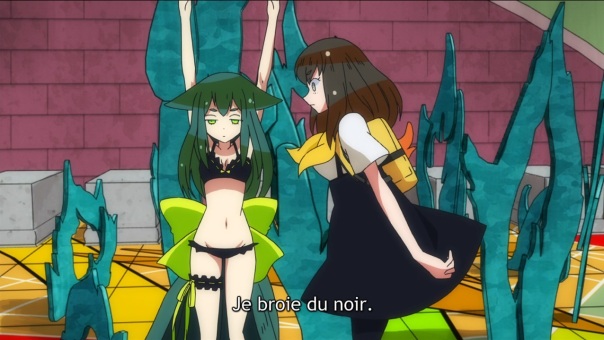
.
Characters with sex-appeal… but a chaste camera
It’s also pretty easy to directly assume that Utsutsu’s idealized body and unexplained choice of outfit make her a fanservice doll, yet Gatchaman Crowds is a series with a weird relationship with objectification. I say that for basically one big reason: the “camera” never seem to give a single damn about the fact that Utsutsu is half naked. Or that Hajime has big boobs for that matter. It’s kind of the opposite of the much-discussed fanservice style of Bayonetta.
While certain character have traditional sex-appeal, nobody ever take a sexy pose for the camera in this season, and the camera gives that uncaring attitude back to the characters. Utsutsu would be extremely easy to sexualize with her outfit, yet it never happens. And by that I mean that the camera never objectifies Utsutsu by zooming on her body parts. She is filmed just like the other characters: with mostly either wide shots including several characters or zoom-ins on the face in order to show emotional reactions. Contrary to what some people seem to think, Hajime’s boobs are also pretty ignored throughout this season (though this particular point get way shakier in Insight). I have counted only three boobs shots in this season, and every time, the camera was actually looking at something in front of the boobs. Two of these shots are in this episode and showcase J.J. hand & Hajime’s NOTE, and the third one is in the last episode and depicts Hajime’s new red ribbon.
So why I would not argue that Utsutsu’s outfit is not fanservice, there is an interesting normalization of the characters’ sex appeal throughout the series. And there is also the question of when Utsutsu choose to wear this outfit, which will evolve through the season. On the other hand, there is an exception to this normalization, as Rui is in fact objectified by the camera a few times (with zoom-ins on his heels and his zettai ryouiki). I’m not entirely sure why this difference exists, but hey, that gives us something to elucidate in the next episodes!
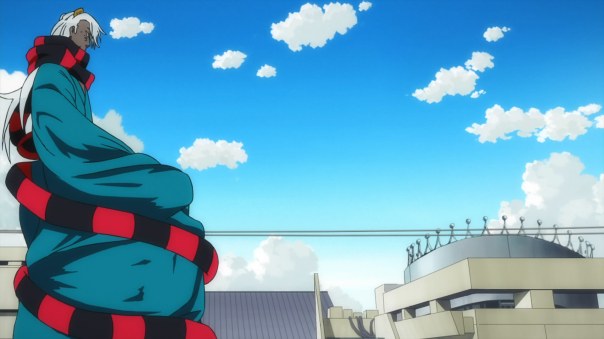
There is one thing I want to talk about on that subject and that’s the scene where J.J. gives Hajime her NOTE. It’s a pretty disturbing moment because of its imagery with J.J. towering Hajime and bringing her under his cape before showing his arm in her chest to extract her NOTE. I’m still not sure if it’s even intentional or not considering that Insight’s equivalent scene made it even worse by having Tsubasa run away from J.J. in terror, which makes him seem even more like an aggressor.
Despite this, no, I would not say that this scene is purposefully sexualized either, because all the usual visual and audio cues used in dirty animes are missing here. While Hajime is moaning, it sounds nothing like what you hear in porn animes, she is not blushing, and like in the rest, she is not moving or posing in any sexy way, nor is the camera particularly making things exciting either. Compare with the teeth brushing scene of Nisemonogatari, as it is once again a perfect opposite: something benign made sexual with the help of anime codes.
Here are some other counter-examples of clear purposeful objectification in other animes to show you how different it is from Gatchaman Crowds’ directing: in this cut of Sakurasô episode 8, you get some real objectification through camera work, character posing, and codes such as blushing and boob jiggle. The episode 5 of Nagato-chan also features some actual boob shots. You will find nothing similar to these two examples in the first season of Gatchaman Crowds.
.
Conclusion
Gatchaman Crowds is a series that accomplishes so many things in only twelve episodes, by constantly having its cake and eating it. While this first episode focuses on introducing the cast without yet revealing the themes of the story, it still manages to sprinkles some hints and is entirely consistent with the rest of the season. It is a magnificent trap that plays with the expectations of the spectator, to the point where I tend to see it as a satire of certain animes tropes, such as rude extra who exists just to cast a favorable light on the main character, or the camp gay “okama” quite often used to make non-hetero and non-cis people a simple joke.
I hope you didn’t mind me saying “we’ll study this in a future episode” too much, there is definitely more to come. In the next episode, we’ll go past the hints and really start to dig into the numerous themes of the series, along with what Hajime’s character is really about.
